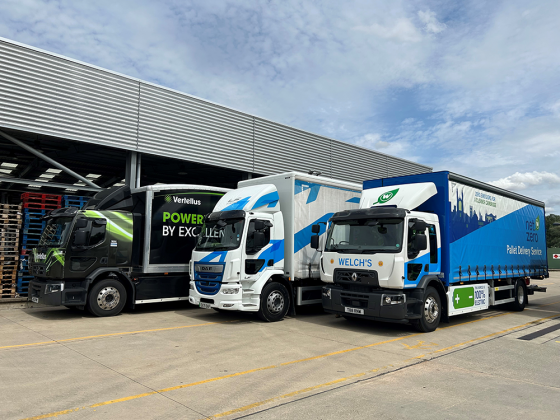What’s your green fleet strategy?
Essex County Council scooped an award for having the ‘greenest’ public sector fleet of over 500 vehicles at last year’s GreenFleet awards. We find out how this success was achieved
Essex County Council has taken a holistic approach to greening its fleet. As well as procuring lower emission vehicles and investigating alternative fuels, the council encourages and incentivises staff to reduce business mileage by introducing measures such as car sharing and teleconferencing. Volunteer environmental champions in each department encourage colleagues to keep emissions down and family fun days get the whole community involved in the green agenda.
Q What vehicles make up the council’s fleet?
A Our fleet is made up of 850 vehicles, 74 per cent of which are cars. Our commercial fleet consists of mini buses, highway vans and a few mobile libraries. We also have spot hire for pool vehicles that are less than a year old.
Q In what ways have you ‘greened’ your fleet?
A We outsourced our fleet in 2008 on a buy-and-lease back contract. The idea was to rationalise our fleet, looking closely at what vehicles were really needed and replacing any old vehicles with more energy efficient models. We set an emissions cap of 160g CO2/km for any new delivery and we are pleased to say that our car fleet is now averaging 135g CO2/km. In terms of reducing the size of our fleet, we looked long and hard at any vehicles that had done less than 12,000 miles and queried whether they were truly needed or if we could survive without them.
We’ve also introduced a sustainable transport policy where we encourage and incentivise staff to use alternative forms of transport and different ways of working to reduce business mileage and emissions. This involved negotiating a ten per cent discount on rail and bus transport for staff travel and interest free loans for annual rail season tickets for home-to-work mileage. We’ve also introduced car sharing and cycle hire as well as interest free loans for bicycle purchases and rail travel. In addition, web conferencing and teleconferencing give staff an alternative to travelling to attend meetings.
Telematics to monitor staff driving has also proved successful. A report is generated that identifies who is not driving fuel efficiently, for example by speeding or harsh breaking. We then give those people training to become ‘greener’ and safer drivers. We’ve used various training providers such as Motivate, the Energy Saving Trust and IAM fleet. For me training is the most important aspect of our green fleet strategy; if your staff do not understand why they are doing something then you are not going to get good results. You have to get everyone onboard.
Q Have you had any resistance from staff due to these changes?
A We thought we’d get some resistance from staff by introducing telematics as we are monitoring their driving. But in actual fact they’ve been very good. They want to see emissions down and be up there with the best performing councils.
Q How has your green fleet strategy been successful?
A Since 2007 we have had a 6.2 per cent reduction in emissions for our car fleet and three per cent reduction in our commercial fleet.
In the future, we are aiming to reduce the emissions from our car fleet and grey fleet by 15 per cent by 2012 and our commercial fleet by 10 per cent by 2015.
We also plan to reduce business mileage by 25 per cent over three years.
Q Have you investigated using any other alternative fuels?
A We have an electric car on order which we will trial for a year. We’ve also taken out a green electricity contract so that the electricity that powers the car comes from renewable sources.
We will be interested to hear user feedback as we want to be 100 per cent sure electric vehicles are right for us. If it proves successful then we will look at whether we can create a charging infrastructure throughout Essex.
We also considered doing a trial on sustainable biofuel. But because the government doesn’t give tax back on blends of more than five per cent, we loose out financially. There are also not many places where you can actually fill up in Essex.
Q What advice would you give to other fleet managers looking to ‘green’ their fleet?
A We would say look good and hard at your fleet. If there are vehicles that are barely used or inefficient then they shouldn’t be there. It’s a hard decision to make. Lots of fleet managers hang on to fleet because they’re afraid they might loose it all. But if anything, rationalisation makes a fleet stronger because what you have got left is good quality.
We would also advise fleet managers to set a limit on the CO2 levels for new vehicles. We’ve set the target of 160g CO2 per km so if any staff wants a car it has to meet that criteria. It’s interesting because lots of staff thought they wouldn’t be able to have larger vehicles any more. But manufacturers are doing amazing work creating larger vehicles that still have low emissions. So fleet managers should have a policy that looks at emission levels rather than engine size.
Fleet managers should keep an eye on the market so they know what’s new in terms of green vehicles and alternative fuels.
Top five tips
- Keep staff fully informed about your objectives and of any changes that will happen
- Get rid of any vehicles that are not needed
- Set a limit on the CO2 level of new cars
- Invest in training to make staff safer and greener drivers
- Incentivise staff to use alternative forms of transport
For more information
Web: www.essex.gov.uk






